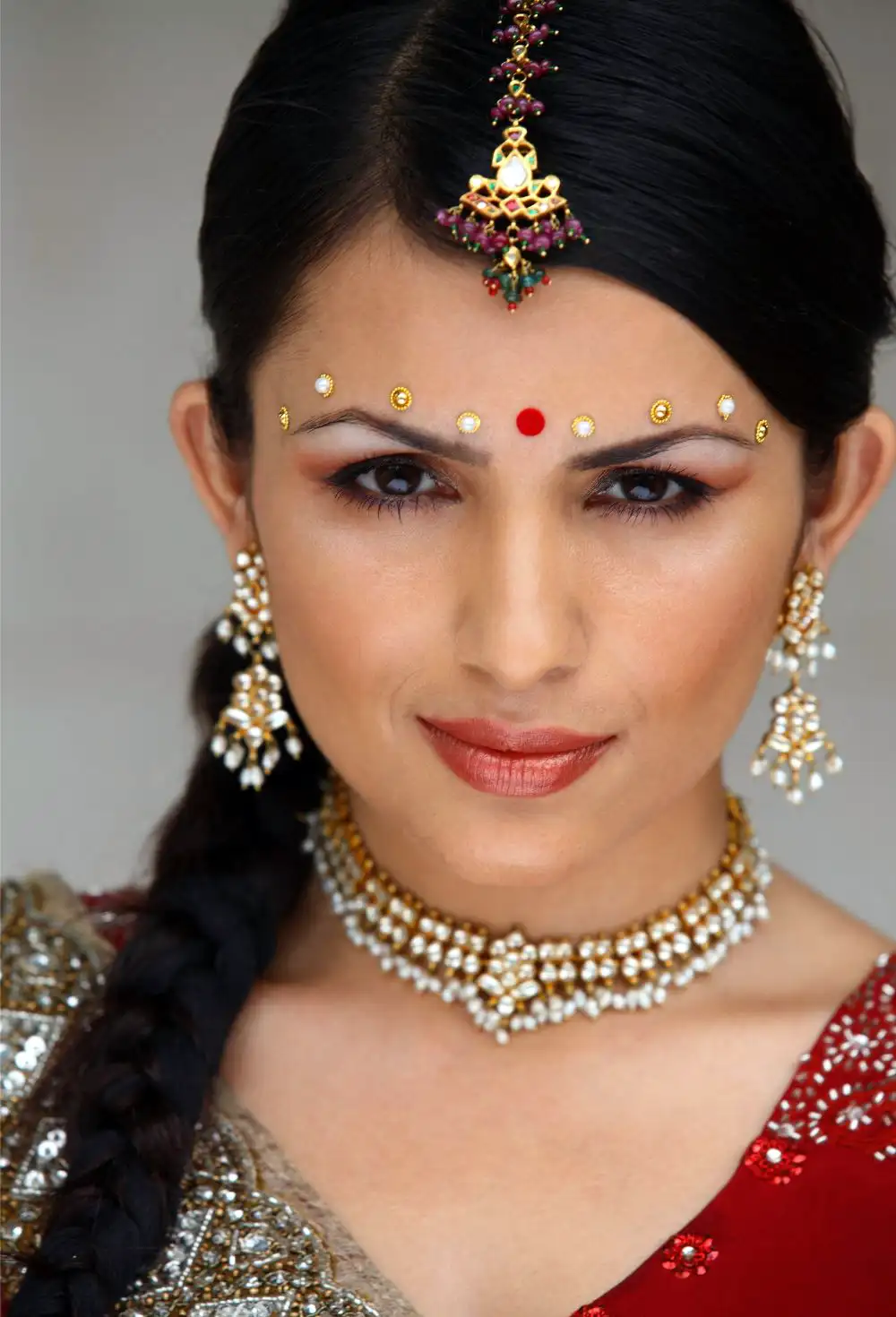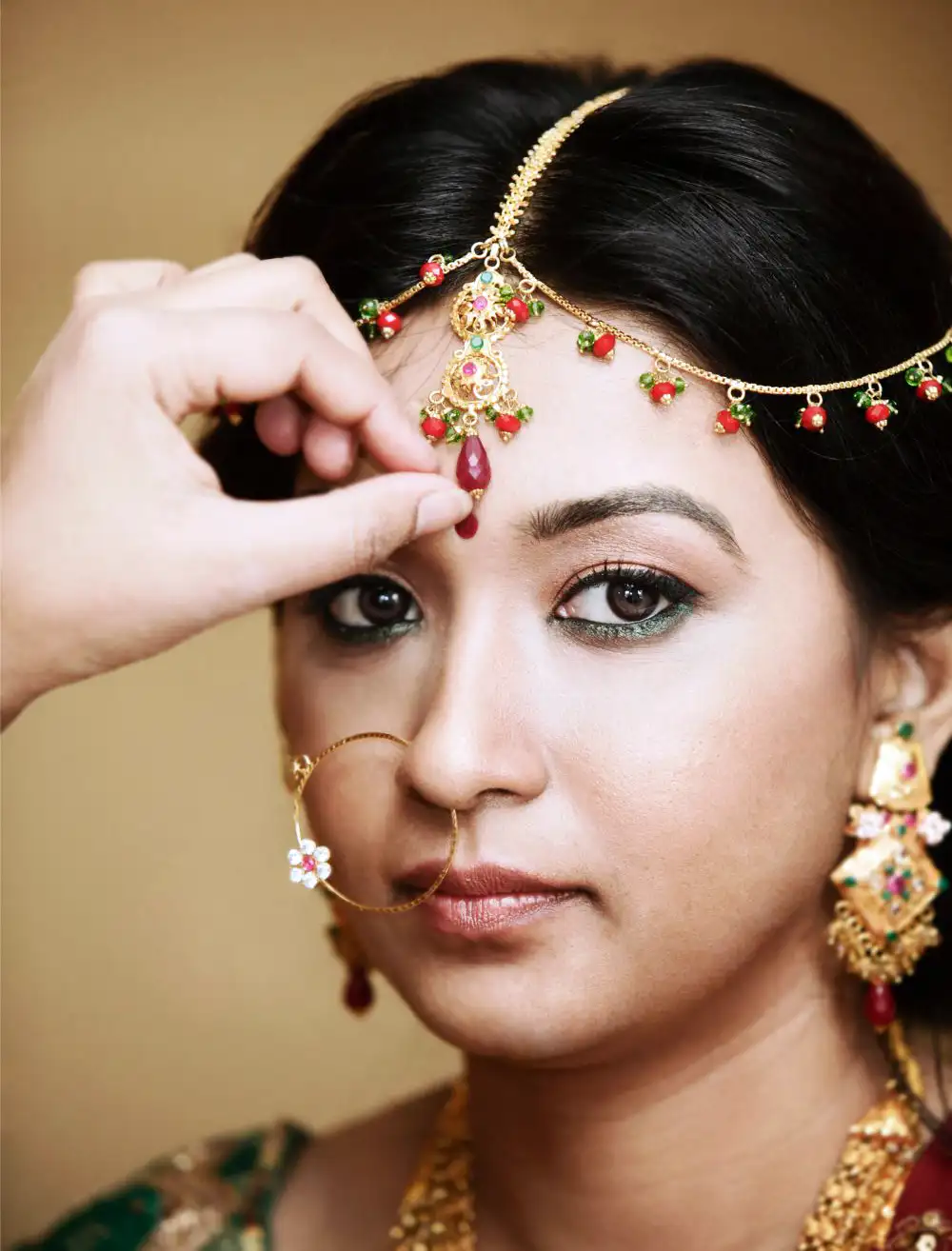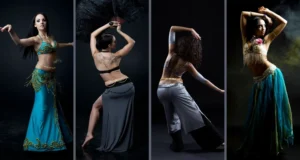The enigmatic bindi, the tiny dot splashed on the forehead, is more than just a decorative bindi for Indian women – it carries many meanings and purposes. While the aesthetic appeal and fashion trends prompt some women to don the bindi, for others, it signifies much more.
The bindi has been a religious symbol connecting women to the divine for centuries. The bindi represents intuition, wisdom, and spiritual power as a third eye. It denotes transcendence from the material world through this all-seeing eye.
Even today, many women wear the bindi as a sign of devotion and faith, seeking protection from the goddess Lakshmi.
Beyond religious purposes, the bindi is a cultural identifier for Indian women. Depending on the color, shape, and materials, it indicates marital status, social standing, and occasion. Women flaunt the bindi with pride, connecting to their cultural roots and traditions.
As aesthetic appeal and globalization spread the bindi beyond Indian borders, its meaning has diversified. Today, the funky dot on a woman’s forehead may indicate artistic expression, reimagining culture, and personal style.
Whatever meaning each woman ascribes to her bindi – devotion, identity, fashion, or self-expression – this tiny but significant symbol empowers women by boosting confidence, creativity, and connection to the divine, culture, and self.
Here we go with one by one profound explanation of why Indian women wear a bindi.
Why do Indian women wear bindi?
Religious significance
Indian women have worn bindi for centuries for its deep religious and cultural significance. The bindi symbolizes the Ajna or “third eye” chakra, the seat of wisdom and enlightenment. According to Hindu belief, wearing a bindi helps open this third eye and bring one closer to spiritual awakening.
The bindi is also related to the Goddess Parvati, the consort of Lord Shiva. Parvati is often depicted wearing a bindi, which is seen as a sign of her powers. By wearing a bindi, Hindu women show their devotion to Parvati and seek her blessings.
Beyond religion, the bindi is an important part of Indian culture. It indicates a woman’s marital status – traditionally a married woman wears a red bindi while a single woman opts for black or white.
Even today, the bindi has become more of a fashion statement, though it retains its traditional role for many women.
Small and ornate bindi has been part of a woman’s attire for centuries in India. The simple black dot between the eyebrows symbolizes an inner spiritual vision, while the large decorative bindis indicate joy, beauty, and cultural pride.
For most Indian women, the bindi is not just cosmetic but carries deep religious significance and cultural identity.

Traditional and cultural significance
Indian women have worn bindi for thousands of years as an essential part of their traditional attire. The bindi spotlights Indian womanhood and identity.
The bindi shows marital and social status. A married woman typically wears a red bindi, while a single woman opts for black or white. Larger bindis signify high social status.
The bindi is related to the goddess Lakshmi, who is often depicted with a third eye. Wearing a bindi brings blessings from Lakshmi and good luck.
For centuries, the bindi has allowed Indian women to exhibit their culture and tradition. Even when bindis became fashionable for women of all backgrounds, they sustained importance for many Indian women.
Bindis appear in various colors, shapes, and sizes, but the simple black dot between the eyebrows symbolizes inner vision. Ornate, decorative bindis denote beauty, joy, and pride.
For Indian women, bindis are not just decorative – they hold deep religious and cultural significance. Bindis establish one’s womanhood and identity as Indian.
Married women wear red bindis, signifying their commitment and love for their husbands. The bindi spotlights a woman’s status in society and success in life. Despite trends, bindis remain a badge of Indian culture.
Aesthetic reasons
Indian women wear bindis for various reasons, but the aesthetic appeal is a major factor. Bindis come in diverse shapes, sizes, and colors, allowing women to find ones that complement their beauty and personality.
The simplicity yet elegance of the bindi design makes it an appealing accessory. Whether small and modest or large and ornate, bindis add charm and grace to a woman’s face. The dot in the center of the forehead draws attention to the eyes, highlighting a woman’s beauty.
Bindis are versatile – they match well with both traditional and Western outfits. A large decorative bindi enhances the look of an Indian saree, while a small dot-shaped bindi gives a touch of ethnic flair to a casual ensemble.
The right bindi completes a woman’s overall appearance, bringing visual balance and harmony.
Bindis serve as canvases for a woman’s creativity. They come decorated with embellishments like beads, stones, and embroidery, allowing women to find unique designs that express their individuality.
Women enjoy experimenting with different bindi shapes, sizes, colors, and materials to match their mood and outfit of the day.
Though bindis hold religious and cultural significance for many Indian women, aesthetic appeal remains a major factor in their popularity.
The decorative dot perfectly accentuates a woman’s facial features, highlighting her femininity and grace. Bindis empower women to feel confident and beautiful by simply adorning themselves with these beautiful yet simple art pieces.
Practical use
Indian women have been wearing the bindi for centuries, and in ancient times it served practical purposes in addition to its religious and cultural significance.
The bindi was traditionally made of ingredients like sandalwood and turmeric powder with antiseptic and medicinal properties. These helped protect the forehead from heat, sweat, and infection. The paste from sandalwood and turmeric acted as a disinfectant for the skin on the forehead.
Bindis made with sandalwood and turmeric powder were believed to relieve headaches and reduce inflammation. These ingredients have antioxidant properties that protect the skin from damage.
The bindi also had protective functions. It was seen as a way to ward off evil spirits and protect oneself from harm. Since it was applied to the ajna or “third eye” chakra, wearing a bindi was thought to improve intuition and increase spiritual awareness.
Although the bindi is no longer as commonly used for its practical benefits as it once was, it retains its meaning as a symbol of tradition and culture for Indian women. Today the bindi is more of a fashion accessory, but it signifies much more for many women.
The bindi is a versatile symbol with diverse purposes – practical, protective, religious, and aesthetic. For centuries, it has been an essential part of an Indian woman’s attire, accentuating her beauty while safeguarding her health, spirituality, and cultural identity.

Auspicious reasons
Indian women wear bindis for many reasons, but one key reason is their auspicious and lucky symbolism.
The bindi is seen as an auspicious symbol that brings good fortune and wards off evil spirits in some parts of India. It is worn as a way to seek blessings and protection.
Red bindis, in particular, are considered lucky since Hindu gods and goddesses favor the color red. Wearing a red bindi invokes the blessings of Lakshmi, the goddess of wealth and fortune.
Hindu women often wear a bindi during auspicious occasions and rituals to increase the sense of sanctity. The bindi is applied on the 6th chakra, known as the “third eye”, the center of intuition and spirituality.
Wearing a bindi during important events is thought to enhance one’s focus and raise spiritual awareness.
The bindi also serves as a daily reminder for Hindu women to center their thoughts on God. Wearing a bindi daily helps them recognize their higher purpose and seek divine blessings.
While many women wear bindis as a fashion statement today, the auspicious symbolism cannot be downplayed. For centuries, the bindi has brought luck, blessings, and protection to Hindu women.
Though aesthetic appeal may compel some women to don a bindi, others wear theirs to strengthen their spiritual connections and imbibe positive energy.
The bindi is a versatile symbol with multiple meanings and functions. For many Hindu women, the bindi remains an auspicious symbol that wards off evil and attracts good fortune through spiritual connection, ritual sanctity, and divine blessings.
Fashion reasons
The bindi has become increasingly popular as a fashion accessory in recent years, and women of various faiths and cultures now wear bindis to express their personal style.
Bindis come in different shapes, sizes, colors, and embellishments, allowing women to find ones that complement their outfits and personalities. Glitter, stone studded, and delicate kundan bindis have become fashion trends, adding glamour to Indian and Western looks.
Bindis allow women to experiment with diverse designs and patterns according to their mood and occasion. Large and ornate bindis make a style statement at weddings and parties, while small and simple bindis can be worn for casual everyday wear.
By decorating their bindi, women express their creativity and individuality through personal adornment.
Women enjoy wearing matching bindis with other hair accessories and jewelry to create an aesthetically pleasing coordinated look. Bindis add visual balance to an outfit and highlight facial features like the eyes, emphasizing a woman’s natural beauty.
While the bindi originally held religious and cultural significance for Indian women, it has evolved into an international fashion icon.
Though women of all faiths and cultures now wear bindis as a fashion accessory, it is important to respect the cultural significance of the bindi for millions of Indian women. Bindis should foster diversity and individual expression rather than cultural appropriation.
The bindi is a versatile accessory that allows women to demonstrate their style through self-expression and creative adornment. As a fashion trend, the bindi remains faithful to its origins while empowering women to flaunt their style confidently.
Regional differences
The style and design of the bindi vary across different regions of India, reflecting each region’s diverse customs and traditions. The vast array of bindi designs adds color and depth to Indian culture.
Different states use distinct materials and shapes to create their signature bindi style. In Maharashtra, bindis are typically made from a red kumkum powder and worn in round shapes, though triangles and moon shapes are also common.
In Rajasthan, bindis are often crafted from black kajal and worn as small dots. Women in Bengal prefer white chandan-based bindis in circular, lotus, or star designs. Meanwhile, bindis in Tamil Nadu typically feature yellow turmeric and are shaped like flowers or the sun.
Bindi designs also differ according to the occasion. Festive occasions like Diwali call for elaborate designs featuring beads and stones, while simple black or red dots suffice for everyday wear.
Brides in each state showcase regional bridal bindi art, featuring decorative motifs ranging from alpanas in Bengal to matha pittas in Tamil Nadu.
The vibrant array of bindi styles demonstrates how local customs and traditions shape this universal symbol. Each state gives the bindi a unique identity that reflects its cultural heritage. Bindis made from different natural pigments allow women to express their regional identity through subtle variations in color and shape.
The vast diversity of bindi designs across India exemplifies how local influences imbue universal symbols with distinct meanings.
While simultaneously embodying universal ideals of femininity, womanhood, and culture, the bindi assumes different forms to resonate with individual regions’ social and aesthetic sensibilities. Its beautiful diversity reflects the rich mosaic of Indian culture.

Summary
The small and colorful bindi symbolizes much more than just beauty for Indian women – it signifies religious beliefs, cultural identity, self-expression, and empowerment.
For centuries, the bindi has connected women spiritually as a sign of the third eye linking them to the divine. Indian women proudly wear the bindi, expressing their cultural identity and marital status in its colors, shapes, and materials.
The bindi allows women to showcase their individuality through aesthetic self-adornment while remaining faithful to its religious and cultural origins.
Ultimately, the bindi, in its versatile forms and functions, empowers women by boosting their spiritual, cultural, and personal connections, enabling self-confidence and creativity through established traditions.
FAQ
Do you have to be Indian to wear a bindi?
No, being Indian is not a requirement to wear a bindi. People of all cultures and backgrounds can wear this beautiful and versatile accessory. It symbolizes faith, wisdom, and power and is worn for religious, cultural, fashion, or auspicious reasons. Nowadays, bindis have become popular as a fashion statement, allowing women of different faiths and cultures to express their personal style and add elegance to their outfits.
Do Muslims wear bindi?
Muslims are not required to wear a bindi as part of their religious practices. However, some Muslim women may choose to wear bindis for cultural, fashion, or personal reasons. The bindi is a popular fashion accessory in many parts of the world and is sometimes seen as a symbol of beauty and femininity. For some, it may also symbolize good luck or protection. Ultimately, the decision to wear a bindi is personal, and it varies from individual to individual based on their cultural background and personal preferences.
What is the correct position of bindi on forehead?
The traditional position for a bindi is on the forehead, between the eyebrows. This spot is considered to be the seat of the third eye, symbolizing spiritual enlightenment and wisdom. However, there is no strict rule for the bindi’s placement; some wear it slightly higher or lower based on personal preference. To find the correct position, start from the center of your forehead and place the bindi slightly above it. Experiment with different positions until you find the one that suits you best.
Do Pakistanis wear bindis?
Yes, Pakistanis do wear bindis, especially during Eid celebrations. While the bindi has its roots in Hindu culture, it is also worn by women of other religious backgrounds in South Asia, including Pakistan. However, it’s crucial to be mindful of the bindi’s cultural and religious significance to South Asians, particularly in India, and avoid cultural appropriation. Bindis are traditional Indian fashion accessories, often worn with ethnic attire like saris and salwar kameezes, and modern designer bindis offer a way to express personal style.
Is A bindi a tattoo?
No, a bindi is not a tattoo. It is a dot or mark worn on the forehead between the brows and holds cultural and religious significance, particularly in India. The name “bindi” comes from the Sanskrit word “Bindu,” meaning “dot” or “point.” Traditionally, bindis are applied using materials like kumkum or sindoor and can be easily removed. While they have become popular as a fashion accessory, it’s important to understand and respect the cultural implications of bindis when incorporating them into personal style choices.




